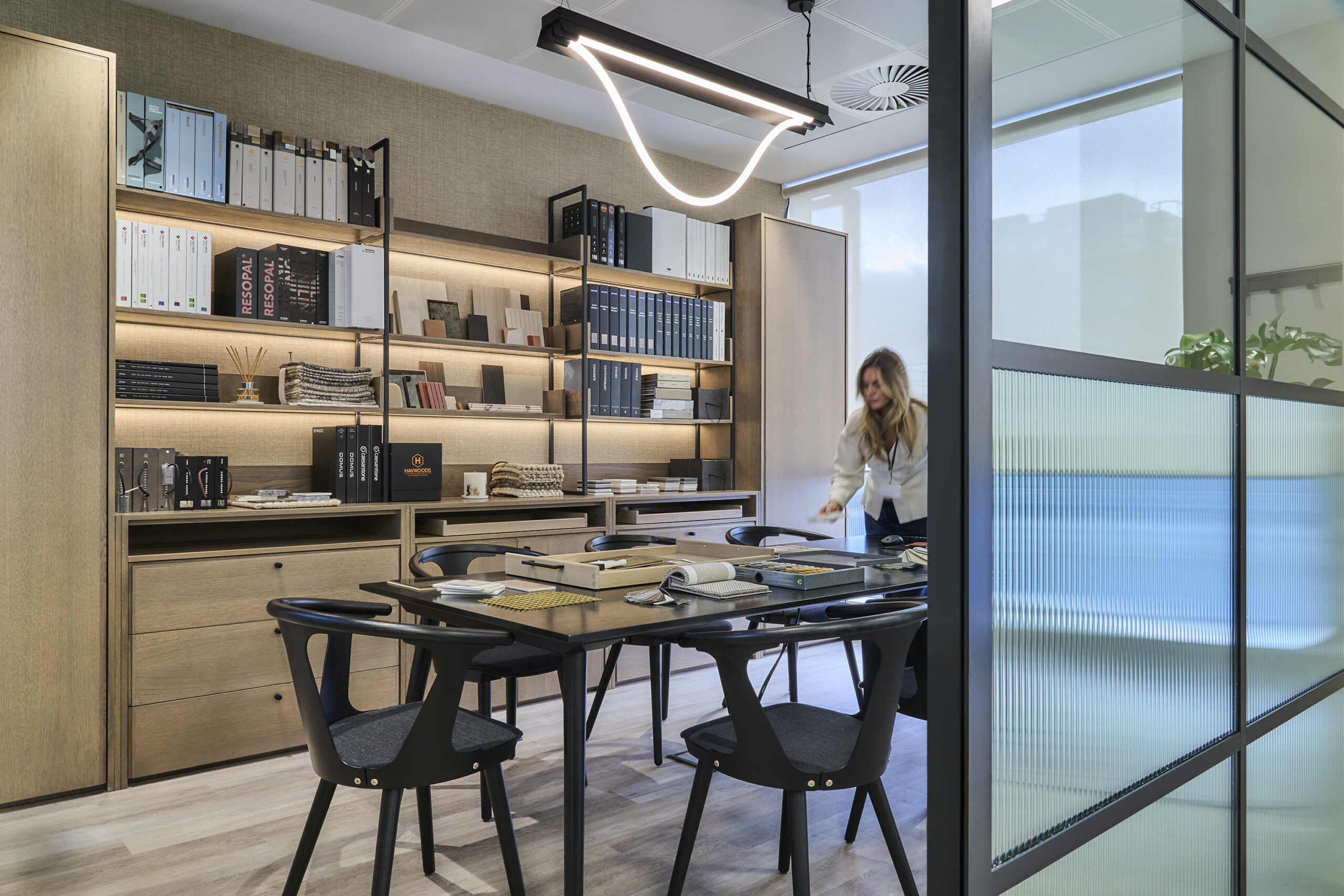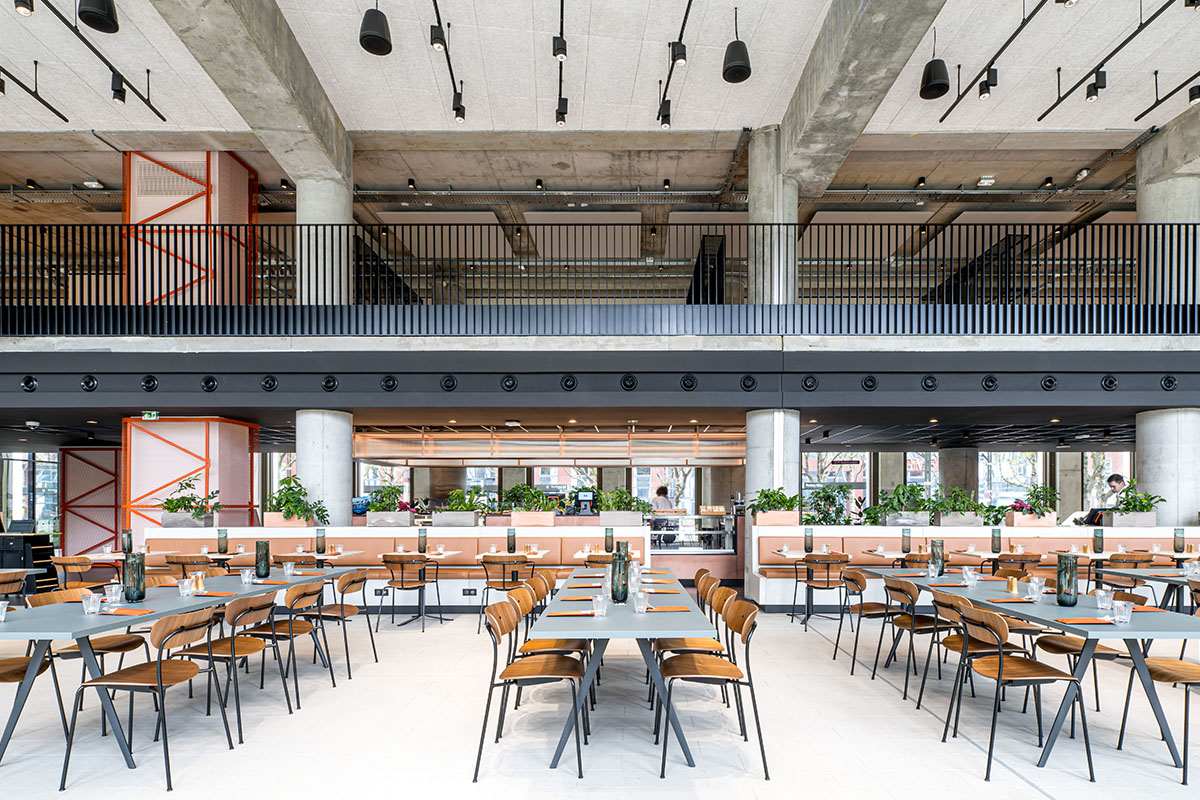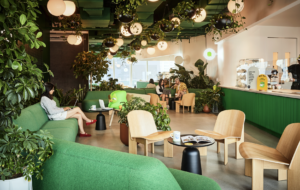 Afroditi Krassa (Image credit: Bernd Ott)|Suede, leather, brass, concrete and timber are used to reflect the local area’s dualities|An aluminium mesh curtain transforms the space from bright, open cafe to dark, moody bar|Hilton Tower Bridge’s 300sq m bar, TwoRuba – designed by Krassa and opened in 2014|Heston Blumenthal’s restaurant, located in Heathrow Terminal 2, opened in June 2014|Krassa’s design for Dishoom in Covent Garden is inspired by Irani cafes in Bombay|Krassa’s studio is behind the brand and retail design of Japanese-inspired food chain Itsu|The AKollection’s Pleat Mirror Panel echoes all the graphical glamour of the 1920s|Piano Tile, part of the AKollection, can be laid out in a variety of different formations|Krassa’s AKollection features art deco-inspired lighting, wall panels and tiles||
Afroditi Krassa (Image credit: Bernd Ott)|Suede, leather, brass, concrete and timber are used to reflect the local area’s dualities|An aluminium mesh curtain transforms the space from bright, open cafe to dark, moody bar|Hilton Tower Bridge’s 300sq m bar, TwoRuba – designed by Krassa and opened in 2014|Heston Blumenthal’s restaurant, located in Heathrow Terminal 2, opened in June 2014|Krassa’s design for Dishoom in Covent Garden is inspired by Irani cafes in Bombay|Krassa’s studio is behind the brand and retail design of Japanese-inspired food chain Itsu|The AKollection’s Pleat Mirror Panel echoes all the graphical glamour of the 1920s|Piano Tile, part of the AKollection, can be laid out in a variety of different formations|Krassa’s AKollection features art deco-inspired lighting, wall panels and tiles||
The first ever female designer at Seymour Powell explains how she turned her back on industrial design for the thrill and theatre of hospitality.
In the male-dominated world of mid-1990s industrial design, it is not without irony that Afroditi Krassa’s career was kickstarted by a bra. Born in the UK but raised in Greece, Krassa moved to London at 17 to study product design at Central Saint Martins and nabbed her first job at Seymour Powell soon after graduation. At that time in 1996, the design mega-agency employed 35 designers – all of them male – and had just been commissioned to design a bra for Marks and Spencer.
“When they told me at the interview I would be the first female designer to join, I was honestly shocked,” laughs Krassa, “but they said, ‘we’ve never found a female designer who’s suitable or good enough for our studio,’ so I thought that must be good news.”
Krassa spent the next three years at Seymour Powell and PriestmanGoode, designing what she calls hardcore industrial mass-produced items for brands like Casio and Minolta – “kettles, watches, irons, vacuum cleaners, you name it” – and interiors for Jaguar and Concorde. Before long, however, she fell out of love with churning out designs that were more styling than true innovation, and felt her entrepreneurial side beckoning.
“My father said you’re either an employer or an employee. I knew I wouldn’t ever fit into somebody else’s setting,” she says. So she left for the RCA, studying Design Products under Ron Arad, with the aim of recalibrating her design direction. She set up her studio post-graduation in 2002 without a business plan, but with a space, a scooter, a laptop, and a clear idea of her creative voice. “I never have big plans – I just go and do things and see where they take me.”
How Krassa found her way to contract interiors was befittingly organic for this ad hoc approach. Starting out, she designed for top-end companies like Ligne Roset and Bonaldo, and noticed many of her pieces ended up in restaurants, bars and hotels. Restaurateur Mourad Mazouz commissioned her to design lighting for Sketch, now a Mayfair institution, and stirred her fascination with the hospitality sector. “It’s about having fun,” she professes in her warm, bubbly manner, “so it’s a theatrical and happy environment by nature.”
She took to writing letters to people she admired, and one week the recipient was Pret A Manger owner Julian Metcalfe. Within days, Metcalfe arranged to meet Krassa and asked her to design the first outpost for his latest venture, sushi chain Itsu. In only eight weeks, Krassa designed and delivered the brand identity, interior, uniforms, packaging, et al. “He had a vision, and I tried to make that tangible,” she says of the collaboration. “It was a crazy time, very stressful, but a massive success.”
The project catapulted her to the forefront of hospitality design, leading to a series of high-profile projects for Café Rouge, Dishoom, Heston Blumenthal and Curzon Cinemas (onoffice 87). Each is contemporary, bold and graphical with sophisticated references to the brand’s message without being corporate or pastiche. Expressly against the idea of a house style, her signature is her process, she says, which looks holistically at the user experience, not just the interior finishes.
“We have a storytelling wheel,” she explains, “which includes all the normal touch points like colours, materials and furniture, and communication, like packaging and signage, but then all these others like smell, sound and feel, that nobody really looks after. What would you tweet about when you leave? What picture would you take?”
If these details aren’t consistent or convincing, she says, consumers nowadays will see through the cracks. Using this approach, she hopes to design ‘category-defining’ projects that challenge and reinvent how things are usually done. “I’d rather design benchmarks than boring stereotypes that mean nothing. You can’t be good at what you do when your starting point is wanting to be like somebody else. You’ll always be second best.”
Her latest project is TwoRuba for the Hilton hotel in Tower Bridge, a café during the day and a bar at night. To allow both functions to thrive in what is essentially a glass box, Krassa’s design is based around a unique aluminium mesh curtain (from Canadian company Cascade Coil) that transforms the space from open and light to dark and intimate.
The studio has also recently launched its first own-brand product range for the contract market, including lighting, wall panels and tiles, which compliments the studio’s interiors work and fills what she sees as a niche in the market.
For her next projects, Krassa will be working with two Greek restaurants, a burrito bar chain, and a Curzon cinema in a Victorian warehouse in Canterbury. In characteristically ambitious fashion, though, her ultimate aim is to be the first to design a restaurant in the air or, even, in space, inspired by chats with Charles Spence, an Oxford professor researching how our other senses affect our taste buds.
“I don’t think anyone’s approached [dining in the air] in an interesting way, considering how gravity will affect the experience,” explains Krassa. “Maybe I should get in touch with Richard Branson.” Judging by her previous experiences, that might just pay off.



















